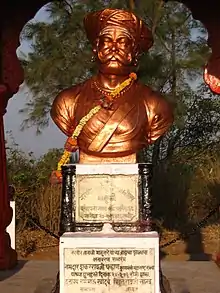Pheta
Pheta (Marathi: फेटा), also known as pataka, is a traditional turban worn in Maharashtra, India.[1]
In ceremonies such as weddings, as well as other festive, cultural, and religious celebrations, it is common to wear a pheta. In many areas, it is customary to offer male dignitaries a traditional welcome by offering them a pheta to wear. A traditional pheta is usually wrapped with a long, cotton cloth typically 3.5 to 6 metres (11 to 20 feet) long and 1 metre (3 feet 3 inches) wide. The fabric of the pheta is draped around the head in 6 to 7 rounds, with a small piece of fabric hanging loose like a tail, called the shemala. Some phetas are plain and single-colored, whereas some are lined and double-colored. The choice of color may indicate the occasion for which it is being worn and also may be typical to the place it is being worn in. Typical colors include saffron (to indicate valour) and white (to indicate peace). In the past, wearing a pheta was considered a mandatory part of clothing.[2]
Varieties
Other than the traditional white and saffron pheta, there are two other major varieties. One is the famous Kolhapuri pheta, which comes in a multitude of colors and has a Bandhani effect on it. The other major variety consists of the Puneri pheta which comes with checkered patterns and has a distinct gold border. A variety of pheta is usually named after a town from which it was made, popularized, or worn; for example, the Kohlapuri pheta is named after the town Kolhapur
Styles
There are different styles of draping a pheta related to the place where it is being worn, the context, and even famous personalities. Geographic styles include: the Kolhapuri style, Mawali style, Puneri style, Lahiri style, and many more. On the other hand, style and varieties are also connected to distinguished persons who wore a pheta, such as Shahi, Mahatma Gandhi, Tukaram Maharaj, and many others.
Innovations
Often the traditional phetas are given a more westernized version that is more colorful, reversible, adjustable, and come in different metallic and satin fabrics as opposed to cotton.
Global appeal
Several Indian celebrities and political leaders have worn the Marathi Pheta in different forms which has given this accessory a global appeal and has made an impact on several people worldwide. Several fashion designers have imitated the style of the Marathi Pheta and have used it to give their collection a touch of Indian ethnicity. Among all the different varieties of Phetas, the Puneri Pheta has been universally considered the most auspicious one that is handed over during the nuptials of a wedding. Gradually, this age-old tradition of Pheta became an auspicious ritual for people, be it any culture.
In media
Many of Marathi movies that show historical Maharashtrian figures, such as Netaji Palkar, Ayodhyecha Raja, Shree Pundalik, depict the character sporting a pheta in most of the scenes. Some Bollywood actors, including Abhishek Bachchan and Ritesh Deshmukh, wore the Pheta on their wedding day. Bachchan's father, Amitabh Bachchan, also wore a pheta to his son's wedding. The current Prime Minister of India, Narendra Modi is also known for wearing a pheta while addressing the nation on Independence Day.[3] Various Marathi Traditional art forms showcase it. The one worn by warriors of great old legends and truth.
Gallery
 Maratha warrior Tanaji Malusare wearing Mawali pagadi
Maratha warrior Tanaji Malusare wearing Mawali pagadi
See also
References
- "All About Marathi Pheta Turban: Interesting Facts And More". Utsavpedia. 2013-07-15. Archived from the original on 2016-09-10. Retrieved 2020-12-11.
- "Kolhapuri Pheta". Kolhapur World. Archived from the original on 2012-10-02.
- "PM Modi continues with flamboyant 'pagadi' tradition, sports Kolhapuri Pheta style safa this I-Day, take a look at his colourful turbans". Zee News. pp. 1–8.